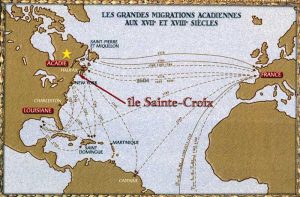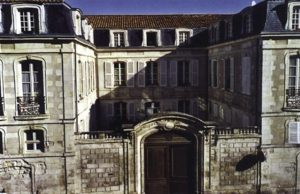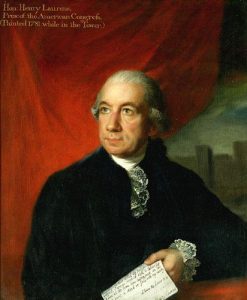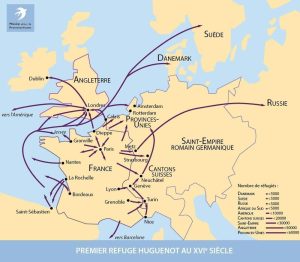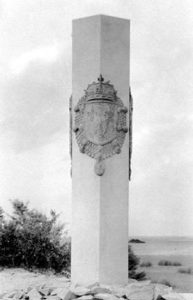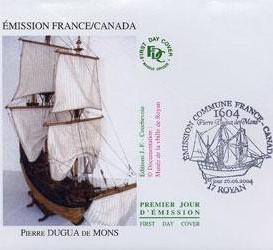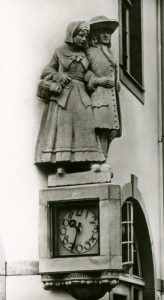As early as the 16th century, Huguenots came to America
Many Protestants took part in the expeditions to Brazil, Florida or South Carolina. It was a dream of instigated by the royal power and initiated by the admiral of Coligny to establish an Antarctic France. But it was short lived because of the competition with Spain, who finally won.
In the 17th century they were present in the Maritime Provinces or in the New England English colonies.
In 1620 when the famous Mayflower arrived in Plymouth there were French people on board. As early as 1662 many people of La Rochelle sent a petition to the governor of Massachusetts asking to settle there and “live with the English”. The reception was friendly. 150 families are estimated to have settled and soon anglicised their names.
After the Revocation of the Edict of Nantes the number of refugees increased. They came either directly from France or through Holland or England. All the Huguenots proved very adaptable and faithful to their new homeland. Some stood out and played a role in the future of America.
New England as a Refuge
The English colonies (New England)was a refuge for European religious dissidents.
An incontestable solidarity linked the Huguenots to England. Towards the end of the 17th century French Reformed believers either came directly from France or through Holland or England, or even reached New France via the English colonies. The families generally arrived with their pastor.
In 1620 when the famous Mayflower arrived in Plymouth there were already some French people on board. As early as 1662 many people of La Rochelle sent a petition to the governor of Massachusetts asking to settle there and “live with the English”. The reception was friendly. 150 families are estimated to have settled. Several soon anglicised their names.
New Amsterdam or New York and the Huguenots
Early in the 17th century the Dutch left for the New World and created the West India Company.
New Amsterdam first surrendered to the English fleet in 1663. In spite of a backlash of the Dutch ten years later, emigration from the Netherlands to the New world then almost completely stopped.
The Huguenots who had arrived massively in the second half of the century were an important part of the population of New York. The majority came from La Rochelle.
The Reformed Church in New York
Pastor Pierre Daillé from Saumur can be considered as the true founder of the Protestant Church in New York. He had the first temple built in 1686.
Pierre Daillé taught at the famous Academy in Saumur, then found shelter in Holland, and then in America in 1683. Assimilation seemed easy and complete. Daillé swore the oath of loyalty to the king of England. The Huguenots however were constantly concerned about keeping a French Church and their language. They were very faithful to the English crown but refused the rites of the Anglican Church. They made constant efforts to keep an independent ecclesiastical organisation.
But it was becoming more and more difficult. The French Church had to be closed between 1776 and 1796. Meanwhile most members of the French Church adopted the Anglican communion.
In 1804 the French church was consecrated by the episcopalian bishop of New York, and called “The French Church of the Holy Spirit” on the 60th Street.
It cannot be called a “colony” because the Huguenots arrived in small separate groups, and had to be naturalised English. So they scattered rapidly.
The Huguenot Church ceased to exist. But the tradition of worship in French was maintained until today.
On the whole the immigrants were of modest origin, but there were also upper middle-class people who had managed to save part of their fortune. Such was the case of Gabriel Bemon, Pierre Baudouin or the Faneuil brothers who were part of one of the first families in La Rochelle. In 1691 they were mentioned as the first French admitted in the Boston colony.
New Rochelle
Between New York and Boston the city of New Rochelle was founded by the Huguenots probably in 1688, in memory of the city so many refugees had fled from.
The inhabitants progressively adopted English and the Anglican rite. But they preserved a French Church called Trinity church. The church received a charter from Georges III dated 1762.
The Huguenots played an important role in creating schools and stood out because of the importance they gave to educating girls.
During the 18th century, New Rochelle preserved its reputation as a center for education and good manners.
Many Huguenots in Virginia and Florida
All the English colonies on the Atlantic coast, from Maine to Florida, saw French Huguenots arrive in the 17th and early 18th centuries.
Like all the refugees they proved of exemplary loyalty to England.
Among the places of Refuge, the city of Manakin, close to Richmond on the James River, where 700 Huguenots settled, kept its original Indian name.
Another Refuge place was Charleston in South Carolina where the ship “Richmond” arrived with about fifty families on board. The journey was financed by the crown of England, so that Huguenots would settle down in that area to develop the culture of vines, mulberry trees and olive trees. They created model farms, carried out land clearing and developed agriculture.
The role and influence of families of Huguenot origin on the American civilisation
The Huguenots showed great willingness to adapt to and integrate their new homeland. Names were anglicised.
New York city included many Huguenots.
For example Pierre Minuit who bought the Island of Manhattan for 24 dollars, according to the legend; Isaac Bethlo from Picardie, who arrived in New Amsterdam in 1652; who gave his name the island on which stands the Statue of Liberty.
Staten Island once called “Huguenot Island” because of the great number of French refugees who stayed there.
In Boston “Faneuil Hall”, one of the oldest buildings, was given to the city by the Faneuil family, who came from La Rochelle, to serve as a public market.
Descendants of Huguenot refugees often played a significant role in the future of America and the development of its civilisation.
Statesmen such as John Jay, Henry Laurens, Elias Boudinot made definite contributions to the American Revolution. Two out of five people who signed the peace treaty consecrating the independence of the United States were descendants of refugees. (John Jay and Henry Laurens).

